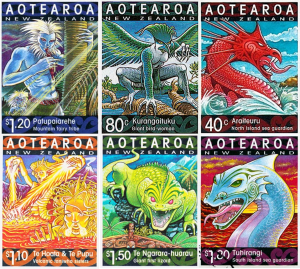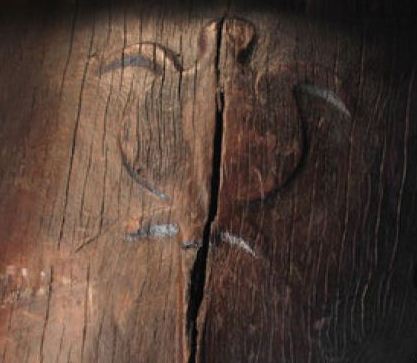 I have always been fascinated by the sea (ironic, since I grew up in a landlocked state) and became obsessed with seafaring cultures as an adult. So, when I heard that Disney was planning an animated adventure set in ancient Polynesia, Moana, I knew it was time to talk about the ocean as a fantasy setting.
I have always been fascinated by the sea (ironic, since I grew up in a landlocked state) and became obsessed with seafaring cultures as an adult. So, when I heard that Disney was planning an animated adventure set in ancient Polynesia, Moana, I knew it was time to talk about the ocean as a fantasy setting.
Of course, we have Le Guin’s amazing EarthSea series, and every pirate tale could technically be considered oceanic fantasy, but I am more concerned with the same vast and largely untapped storehouse that Disney is drawing on: the Polynesian cultures of the Pacific.
Polynesia covers about 16 million square miles. Even though this is mostly ocean between the various islands, this is larger than the landmass of Asia. Nevertheless, the peoples of Polynesia are very closely related, their various “languages” separated by sound differences no greater than those that separate what we call “dialects” in spoken Arabic. The neighboring peoples of Melanesia and Micronesia speak languages that are related to Polynesian about as closely as French, Spanish, and Italian. It’s a remarkably vast area with remarkably similar cultures.
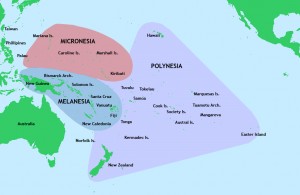 With Disney opening the door on the idea of oceanic fantasy—and researchers uncovering evidence of a vast Polynesian empire, lost to history and centered on the islands of Tonga—the possibilities for epic fantasy set in a quasi-Polynesian setting are before us. And, if you’re unfamiliar with the cultures and mythologies of these islands, you might be surprised to find that the opportunities they present are as rich and varied as any fantasy set in a quasi-European setting.
With Disney opening the door on the idea of oceanic fantasy—and researchers uncovering evidence of a vast Polynesian empire, lost to history and centered on the islands of Tonga—the possibilities for epic fantasy set in a quasi-Polynesian setting are before us. And, if you’re unfamiliar with the cultures and mythologies of these islands, you might be surprised to find that the opportunities they present are as rich and varied as any fantasy set in a quasi-European setting.
So here are few cool things you might not have known about Polynesian cultures. [NOTE: Due to font constraints, I have used the acute accent ´ in place of the usual macron in Polynesian words.]
They had special classes, much like the knights, priests, and monks of Europe.
Polynesians had an expert class—pronounced variously as kahuna, tohunga, , etc.—roughly corresponding to the priestly caste in Indo-European cultures, but encompassing a wide variety of skills beyond the clerical and magical. There were navigators, boatwrights, tattoo artists, astronomers, anthropologists, healers, and many more types of kahuna in addition to the priests and sorcerers.
Moreover, there were exclusive orders, secret societies like the Areoi warrior guild of Tahiti which had several intriguing characteristics, including a hierarchy of seven grades each marked by special tattoos. Both men and women could join, and members of all social strata, although aristocrats got a leg-up in the hierarchy. The Areoi shared all property in common like the Templars, and traveled from settlement to settlement, engaging in raucous parties and rituals. They were even empowered to enforce the rules of tabu.
They had cool human-like races, much like the dwarves, elves, and goblins of Europe.
The Menehune of Hawai’i are probably the best known of the non-human races of Polynesia, but it is very likely that they are merely the cultural memory of an indigenous worker class, manahune in Tahitian, whose legends of labor and construction were conflated by European mythologists with their own myths of industrious brownies.
In fact Martha Beckwith, in her remarkable Hawaiian Mythology, tells us that the Menehune were described as “human” to distinguish them from the “wild” and mysterious Wao race, often referred to as Náwao (with the ná article simply being a plural version of “the”), that was divided into two moieties: the “silent” Mu and the “shouting” Wa. The Mu specifically are described as hairy to distinguish them from the smooth-skinned Menehune. These wild Wao races live in the mysterious, forested uplands, while humans make their homes in valleys and along the shore.
The Máori knew of the Patu-pai-arehe, little fairy people who taught humans how to make nets, and hate to hear humans singing at night—they feel the singing was mocking them. They are related to the Turehu, fair-skinned and light-haired, who wear aprons of seaweed and taught humans the art of tattoo. Having no knowledge of fire, they are suspicious of it and of cooked food. Some legends name their king as Uetonga, grandson of the god of earthquakes.
Another elf-like race known to the Máori are the Nuku-mai-tore who dwell in the trees like birds. Like the Turehu, they do not cook food. A monster bird named Pou-kai hunts the Nuku-mai-tore, attacking them when they descend from the trees to gather water.
While these elfin races seem friendly to humankind, the Turehu even intermarrying with them, the Máori also knew of a hostile race of sea-goblins called the Ponaturi who are slain by sunlight much like European trolls. And the Rarotongans told of a race of nymphs called the Tapairu, the Peerless Ones, who were daughters of the death goddess Miru and would occasionally intermarry with humans, sometimes to lure them into their mother’s oven.
They had some really awesome monsters, like the dragons, rocs, and kraken of Eurasia.
We’ve already discussed the monster-bird Pou-kai, which may be a cultural memory of the gigantic Haast’s Eagle, an extinct raptor with up to a 10-foot wingspan.
The Máori also told of monstrous reptiles like dragons called taniwha. Although many tales record the slaying of taniwha by various heroes, apparently the taniwha can also be tamed and ridden, as the warrior who discovered New Zealand, Raka-taura, rode there on a taniwha named Pane-iraira.
A type of dragon-like monster in Hawai’i named mo’o (the same word used for geckos) lives in caves and can assume human form. In other parts of Polynesia, the cognate Moko refers a sort of dragon-king figure.
Similarly, Paikea was the Máori progenitor of sea-monsters, a sort of Oceanic Echidna. If the Hawaiian cognate for Paikea is any indicator, these are crustacean monsters: pai’ea is a type of crab.
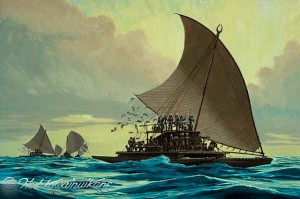 They had theories of magic, and even specific schools of it, just like in Europe.
They had theories of magic, and even specific schools of it, just like in Europe.
You are probably already familiar with one aspect of Oceanic magic. Mana, that measure of spiritual-magical power used in a variety of fantasy systems, is derived from Austronesian culture.
The kahuna magic of Hawai’i came in a variety of specific categories, including predicting future events, praying someone to death, controlling spirits to do one’s bidding, and healing.
The Máori had a special category of magical incantations called karakia, each with a specific purpose. There are karakia for calming an angry sea, eliminating pain, sharpening weapons, opening holes in rock, putting someone to sleep, and even to exchange heads with someone else! You have to be careful, though; reciting a karakia improperly can be fatal!
They had amazing gods and heroes to rival those of ancient Europe.
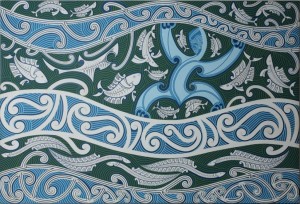 Some religions have one main god, some have three, some like the Greeks have a pantheon of twelve. In Polynesia there are a four main gods. These are known as Kanaloa, Káne, Kú, and Lono in Hawai’i, Tangaroa, Táne, Tú, and Rongo in New Zealand. (See how similar the languages are?)
Some religions have one main god, some have three, some like the Greeks have a pantheon of twelve. In Polynesia there are a four main gods. These are known as Kanaloa, Káne, Kú, and Lono in Hawai’i, Tangaroa, Táne, Tú, and Rongo in New Zealand. (See how similar the languages are?)
Interaction with Christian missionaries led to the last three getting lumped together like the Christian Trinity, but they were originally a foursome, with Kanaloa and Kane often invoked side-by-side as many dual gods in other cultures are, like Mitra and Varuna or the two aspects of Roman Jupiter, Dius Fidius and Summanus.
Tangaroa was a mysterious octopus god long before Lovecraft was cool, a god of the sea who is considered on some islands the supreme creator god. Elsewhere he is the son of Earth and Sky, like Cronos of Greek myth.
Táne is the god of art, light, and the forest, who created humankind.
Tú is a war god, who (much like the Hindu Śiva) has a range of cool sobriquets like The Angry Face, The Destroyer of Armies, and The Seizer of Land. He is married to the moon goddess Hina.
Rongo is the god of rain, agriculture, and music. His Hawaiian counterpart, Lono, was married to the hula goddess Laka.
Of course there are many others, like the demi-god hero Máui, the fertility goddess Haumea, and her ever-popular daughter, the volcano goddess of Hawai’i, Pele. (For a song I wrote dedicated to Pele, check out the video below.)
So, if you’re a fantasy writer in search of a unique and intriguing setting other than the typical Medieval European trope, learn more about Polynesia. It’s an incredibly rich and evocative culture filled with epic possibilities!
_
For more information, see: Hawaiian Mythology by Martha Beckwith, Myths and Legends of the Polynesians by Johannes C. Andersen, and Pacific Mythology by Jan Knappert.

